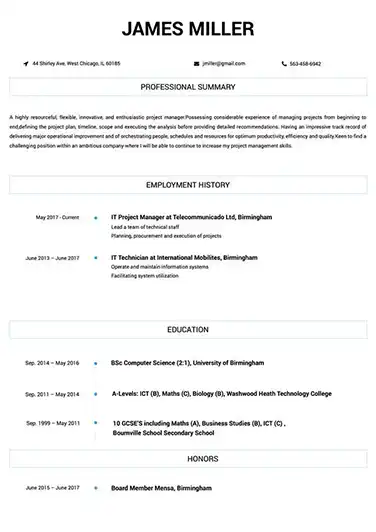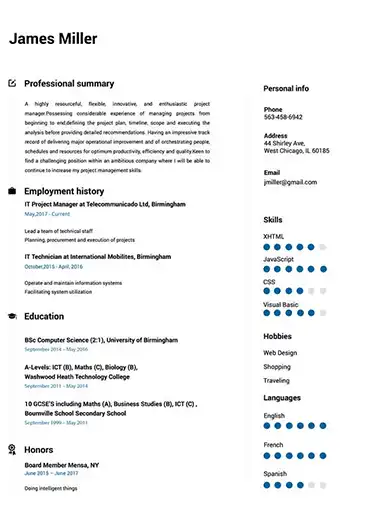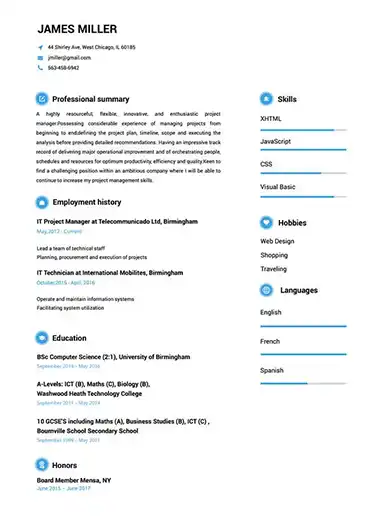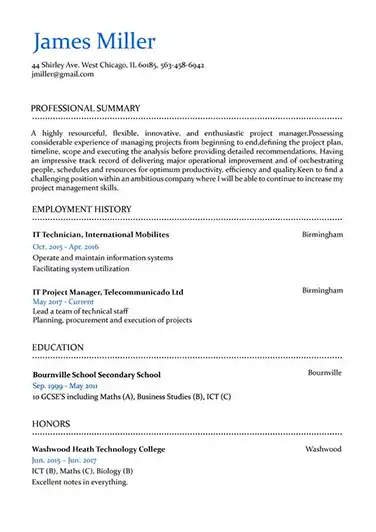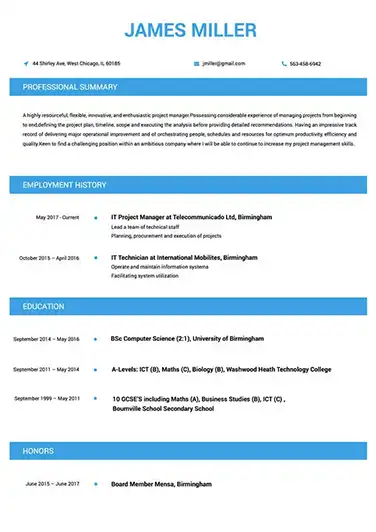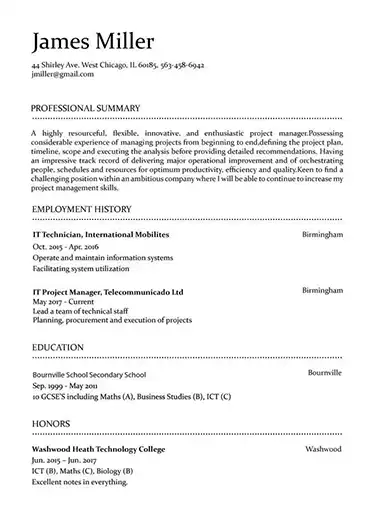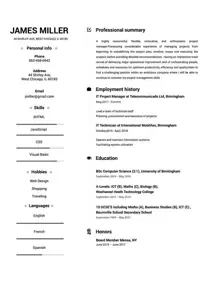 Use This Template
Use This Template
Build your resume in 15 minutes
Create an awesome resume that meets the expectations of potential employers with our selection of professional, field-tested resume templates.
firefighter: Resume Samples & Writing Guide
bernie.king@gmail.com
828-186-8364
Professional Summary
Employment history
- Participate in fire prevention activities
- Provide security services
- Operate firefighting and rescue equipment
- Monitor and respond to security alarms
- Conduct investigations and apprehend suspects
- Investigate the cause of fires
- Enforce safety regulations
- Perform fire suppression and rescue operations
- Provide public assistance and assistance to other agencies
Education
Skills
Do you already have a resume? Use our PDF converter and edit your resume.
frankroberts87@aol.com
810-124-5643
Professional Summary
Employment history
- Perform fire suppression and rescue operations
- Operate firefighting and rescue equipment
- Provide security services
- Provide security services
- Operate firefighting and rescue equipment
- Respond to emergency calls and provide medical assistance
- Provide public assistance and assistance to other agencies
- Enforce safety regulations
- Provide security services
Education
Skills
johnsonsimon@hotmail.com
785-742-2245
Employment history
- Provide public assistance and assistance to other agencies
- Operate firefighting and rescue equipment
- Patrol assigned areas
- Maintain and inspect firefighting equipment
- Participate in drills and training sessions
- Operate firefighting and rescue equipment
- Perform fire suppression and rescue operations
- Conduct investigations and apprehend suspects
- Monitor and respond to security alarms
Education
Skills
adamssimon97@yandex.com
922-627-9677
Professional Summary
Employment history
- Maintain and inspect firefighting equipment
- Monitor and respond to security alarms
- Conduct investigations and apprehend suspects
- Respond to emergency calls and provide medical assistance
- Enforce safety regulations
- Participate in drills and training sessions
- Maintain and inspect firefighting equipment
- Monitor and respond to security alarms
- Conduct investigations and apprehend suspects
Education
Skills
long-hal@protonmail.com
801-860-6943
Professional Summary
Employment history
- Respond to emergency calls and provide medical assistance
- Administer first aid and CPR
- Monitor and respond to security alarms
- Monitor and respond to security alarms
- Participate in drills and training sessions
- Participate in fire prevention activities
- Participate in fire prevention activities
- Provide public assistance and assistance to other agencies
- Administer first aid and CPR
Education
Skills
Not in love with this template? Browse our full library of resume templates
You’re an unsung hero of everyday life.
But one thing you don’t want is for your resume to be unsung.
So, how do you write a resume that’s guaranteed to get you noticed by the chief?
How do you sell your skills as a firefighter, without sounding like every other person applying for the job?
Being a firefighter is a pretty good gig. After all, check out the latest pay-by-state data for the average firefighter in 2019:
And that’s not to mention all the other benefits.
But being a firefighter also requires a lot of additional training and you need to keep your mind and body in good shape.
In the guide below, we’ll show you how to put all that together into an attractive resume that shows the chief you’ve got what it takes to join the team.
This guide is for you if:
- You’re a veteran firefighter who wants to know the best way to sell your accolades, results, and certifications
- You’re an experienced firefighter who doesn’t have a laundry list of accolades, but a few good sparks that you want to make sure the chief notices
- Or an aspiring firefighter who wants to land your first job at a local fire department
If any of those apply to you - fighting fires is your job.
We’ll show you how to fight– and win– the job so you can get to doing what you do best.
What this guide will cover
In the guide below, we’ll cover everything you need to know to format and write a blow-out firefighter resume.
Including:
- What the most important sections to include in your resume are
- How to write your resume in a way that gives recruiters exactly what they’re looking for
- Using your training and certifications to help you stand out above the rest
- How to write a firefighter resume with little or no experience
- And how to prepare for a job interview as a firefighter
- Plus much more
Writing a killer resume takes work, but designing a template that impresses the chief doesn’t have to. Save hours of time and the hassle of designing your template by checking out Resumebuild’s full library of ready-made templates here.
Resume examples
How to write a firefighter resume that makes the cut
Writing a great resume isn’t art - it’s science.
And I’ve got just the formula to help you get noticed like a fire truck blazing down Hollywood Blvd.
It’s easy to find information on crafting a great resume, but some of that doesn’t apply to firefighters.
Plus, there are other points that are important to keep in mind for you as a firefighter that other industries don’t need to include.
So, let’s start first with how to format your resume, which can be pretty simple.
However, if you’re willing to take it a step further, you can adjust your formatting slightly to give you the advantage, whether you’re a seasoned vet or aspiring recruit.
1. How should you format your resume?
It’s easy to overlook the importance of formatting your resume and go straight into writing.
That’s a big mistake.
Why?
How you format your resume tells the recruiter what you want them to see and in what order.
If you put your experience at the top, right after your objective or summary?
They’ll focus more on your experience than your skills, accolades, and any certifications you have.
But what if you have an impressive list of training certifications?
Put that at the top and you’ll immediately give a great impression.
Here’s a quick guide to help you decide how to format your resume:
- Have a ton of certifications, training, or accolades? Put that section you have at the top of your resume.
- Don’t have much of the above, but you do have some decent experience? Go with a basic chronological structure.
- And if you have little to no experience? If you’ve picked up a good range of skills from previous work, volunteer time, or college/high school, put your skills section up top or go with a chronological structure, depending on how good your experience section looks (more on that later).
You could go with a basic chronological order no matter what, but in some cases, you’d be doing yourself a disservice.
We’ll talk about how your resume should look if you have some impressive certifications, training, or accolades you want to show off later.
For now, let’s look at another example.
Let’s say you have very little experience as a firefighter, but you’ve had a few jobs, and a good college and high school experience.
Collectively, you have a number of relevant skills you could mention on your resume that would set you apart.
Instead of this typical chronological structure:
WRONG
OBJECTIVE
[...]
EXPERIENCE
Fedman’s Hardware / Nov 2018 - Aug 2020
Supervisor - Portland, OR
- Lead a small team of clerks and salespeople
- Helped resolve conflicts between employees
- Managed state compliance for store policies and guidelines
That’s okay.
The experience you mention is relevant to being a firefighter and written in a way that the chief will identify with it.
It is a little lonely though and will have a hard time standing out.
Instead, let’s say you’ve also done some volunteering, you were in the scouts, and you ran track in high school.
You could move your skills section up above your experience section like this and make it even better:
RIGHT
OBJECTIVE
[...]
SKILLS
- Lead team of employees by managing daily responsibilities and resolving internal and customer-related conflicts
- Managed compliance and protocol for medium-sized business
- Knowledge of basic emergency response procedures from time in the Scouts
- 3-Year member of Orpen High track team and maintain a high level of fitness
- Volunteered at Portland City Hospital administering basic medical supplies for use by nurses
EXPERIENCE
Fedman’s Hardware / Nov 2018 - Aug 2020
Supervisor - Portland, OR
- Lead a small team of clerks and salespeople
- Helped resolve conflicts between employees
- Managed state compliance for store policies and guidelines
- Patched up wound waiting for paramedics when an employee cut their hand open with a table saw
Think about how that changes the reading experience.
In the first example, the chief sees a sparse resume without much to write home about.
In the second, they see not only that you have a number of relevant skills that make you a great fit for the job, but also that:
- You want it: If you took the time to organize your skills section like that, your ambition will bleed through the paper.
- You understand a bit about what it takes to be a good firefighter: Even if you don’t have any direct experience.
The truth is, you might be mentioning some pieces from your experience again or pulling relevant skills from irrelevant experience– that’s fine.
In the end, you’re organizing your best selling points and putting them where it’s impossible for the recruiter to miss them (as opposed to spreading them out through, or at the end of, your resume).
As you format your resume, be mindful of both your strong points and how you can best sell them to recruiters.
Where will they look first? Next? And after that? If you were to skim through your own resume, what jumps out at you?
Structuring your resume so that your best points stand out, as well as using bold and italics to help draw additional attention, can help guide the chief to where you want them to look, instead of hoping and praying they see your good stuff.
2. How to give recruiters exactly what they’re looking for
Want to know the #1 mistake that people make when writing their resume?
Not thinking about what the recruiter is looking for.
Imagine the next seasoned fire chief who will read your resume.
Let’s call him Tom.
Tom doesn’t have a lot of time.
In fact, he thinks it’s a pain in the butt just to have to spend all this time looking at resumes when he’s got a million other things to do that involve actually getting work done.
Without even reviewing his job post, he already knows what he’s looking for. After all, he’s the one that wrote it.
If he sees one of those things on your resume, it will immediately let off a spark and catch his attention.
Line up a few of those in a row?
He’ll have to spray your resume down because it’ll be on fire.
So, how do you do that?
Simple– go look at his job post.
This is taken directly from a post looking for a new part-time fire captain:
- “Responds to events including rescues, explosions, and medical emergencies within the area of responsibility and assumes command on the fire ground until relieved by a superior officer.
- Plan, coordinate, assign, direct, and participate in emergency and non-emergency response operations and activities of an assigned shift.
- Organizes and directs all training at the fire department, including apparatus and equipment and emergency medical care.
- Organizes and coordinates all fire station operations which may include fire apparatus, public safety vehicles and fire equipment maintenance.
- Direct and participate in equipment and station maintenance, fire prevention, and inspection, and other operational and administrative assignments.
- Investigates all fires to determine cause and origin.”
That’s a list of duties for the role, but it also doubles as relevant skills and experience you can mention.
What do you do with the information?
This is the cool part.
Let’s take that job post and apply it to a resume for a seasoned firefighter with similar experience, looking to become a fire captain.
Instead of taking that list of duties as a cue and writing it your own way, we’re literally going to write out the relevant experience in a way that the wording matches how they wrote it.
This is called “mimicking” and it’s a super-effective communication trick that helps get your point across.
In this case, “I’m the person for the job.”
Let’s take a look at that example now:
RIGHT
WORK EXPERIENCE
Firefighter / Oct 2015 - Feb 2019
McAlester Fire Department Central Fire Station - Pittsburgh, IL
- Mobilized crew to respond to rescues and medical emergencies and assumed command on the fire ground.
- Planned, coordinated, assigned, directed, and participated in emergency and non-emergency response operations.
- Directed and participated in equipment and station maintenance and other operational and administrative work.
- Trained seven recruiters in all areas including department rules, protocol, and policies
- Acted as a reliable leader to my crew, often resolving conflicts and making important decisions that affected the team.
Now that would jump out at the chief and make him sit up.
Notice how close those first 3 points are to the original job post.
The lines we referred to in the job post:
- “Responds to events including rescues, explosions, and medical emergencies within the area of responsibility and assumes command on the fire ground until relieved by a superior officer.
- Plan, coordinate, assign, direct, and participate in emergency and non-emergency response operations and activities of an assigned shift.
- Direct and participate in equipment and station maintenance, fire prevention, and inspection, and other operational and administrative assignments.”
And our version:
- Mobilized crew to respond to rescues and medical emergencies and assumed command on the fire ground.
- Planned, coordinated, assigned, directed, and participated in emergency and non-emergency response operations.
- Directed and participated in equipment and station maintenance and other operational and administrative work.
You don’t want it to be word-for-word, but with a few small tweaks, using virtually the same language they used creates a clear pathway to communicating that you have the right skills for the job.
Of course, you only want to do this for the experience you have that matches what they mention in the job description.
However, whatever you have that fits the bill should be written this way to make the most of it.
As opposed to this generic version of the same list of duties:
WRONG
WORK EXPERIENCE
Firefighter / Oct 2015 - Feb 2019
McAlester Fire Department Central Fire Station - Pittsburgh, IL
- Responded to various emergencies and led the team on the fire ground.
- Coordinated response for emergencies and other operations.
- Performed station maintenance and administrative work.
- Trained seven recruiters in all areas including department rules, protocol, and policies
- Acted as a reliable leader to my crew, often resolving conflicts and making important decisions that affected the team.
It might be describing the same experience, but I’ll tell you right now that the chief won’t respond to that even half as favorably as the first example.
It’s just not speakin’ his language.
3. How to write an eye-catching resume objective or summary
Now that you know how to format your resume to get your best selling points out front and the most effective way to frame the writing of your resume to elicit a response, it’s time to start writing this bad boy.
A great firefighter resume always starts with your objective or summary.
Why?
An objective or summary is important for the same reason that formatting your resume effectively is important:
With a good objective or summary, you can immediately draw the recruiter to your most attractive qualities.
In fact, it’s often the very first thing that recruiters look at when they start skimming your resume (and they’ll do it fast– 7 seconds on average, in fact).
That means your objective needs to have the stuff that will really wow the recruiter.
What that is, depends mostly on your experience.
The more experience, certifications, and accolades the better, obviously, as you’ll have more to choose from.
However, there’s a way to write a great opening profile that doesn’t absolutely require that.
What is the difference between a summary and objective?
First, you might be wondering: what is the difference between a summary and an objective?
They’re similar, with one leaning more on experience and accolades and the other leaning more on communicating interest through an objective statement.
When would you use one versus the other? Here’s a basic breakdown:
- Use a summary when: You have a ton of experience and accolades or a key certification, such as paramedic or EMT that sells itself.
- Use an objective when: You have little to no experience and you need to use other means to convince the chief you’re the best person for the job.
Let’s look at two examples.
First, let’s say you’re an EMT who has completed your local firefighter certification.
Both paramedics and EMT are highly sought after by stations, especially with many taking over EMS duties.
So, if you’re an EMT and you’ve completed your basic firefighting training, together those are good selling points.
You could go with an objective such as:
RIGHT
OBJECTIVE
Aspiring firefighter who has completed fire training I and II and is EMT certified. Possesses a calm mind under pressure and quick, decisive thinking in difficult situations. Looking to secure a position as a member of your team at the San Antonio Fire Department, where I can apply my training and medical knowledge.
No experience, but you’d blow it out with that one.
Or, if you have real on-the-job experience, you could go with a summary like this:
RIGHT
SUMMARY
Seasoned firefighter with 4 years of experience handling emergency care and firefighting duties. Proven track record of quick, efficient performance and effective teamwork in a variety of stressful situations. EMT certified.
Both of those are a gigaton better than this simple blurb that doesn’t sell anything in particular aside from your EMT certification:
WRONG
SUMMARY
Experienced firefighter handling a variety of duties. Quick thinker and good under stress. EMT certified. Knowledgeable in both administrative processes and medical equipment maintenance.
First, it’s a little lacking.
You don’t need a bunch of lines of text, but if your summary is too short it will give a bad impression.
Second, the EMT certification gets lost in the middle.
Either put something that important at the beginning or at the very end.
No matter which way you do it, don’t let those key selling points just disappear into the text. Make them memorable, make them count.
Finally, the above summary is far too vague.
Specifics help give context and make what you’re saying more believable.
When you say things like, “variety of duties,” it sounds like you’re making it up.
So, take the time necessary to craft a great resume objective or summary to not only rise above the draft of other resumes, but get them to start thinking - “they could be the one, let me read more…”
4. How to list training, certifications, and achievements as a firefighter
Special training, certifications, and achievements are the secret weapon of firefighter resumes.
Whatever you have, make sure to draw special attention to it, especially if it’s a paramedic or EMT certification.
That’s done in 3 different ways:
- In your objective or summary
- In your skills section
- And in a separate “Certifications” “Achievements” or other details section
Don’t worry about mentioning the same thing multiple times.
All you’re doing by mentioning things several times throughout your resume is guaranteeing that they’ll see it.
Remember: they will skim and therefore are likely to miss one or more mentions of said certification or achievement.
First, here’s a list of potential things you can mention under a special “Certification”, “Special Training”, or “Achievements” section:
Medical
- Paramedic certified
- EMT certified
Firefighting
- Basic firefighting training (typically several levels, list all relevant)
- Fire prevention
- Fire investigation
- Fire behavior and combustion
- Fire services administration
- Fire services
- Fire tactics and strategies
- Fire officer
Safety
- Rescue technician
- Hazardous materials
Leadership/management
- Conflict resolution
- General psychology (relevant if you’re certified in fire investigation)
How to list your certifications
If you have a good list of certifications, you can list them out in a separate certifications section:
CERTIFICATIONS
- Paramedic Certified (EMS1)
- State of California Firefighter Certification (I & II)
- Hazardous Materials Training Certified
If you have an attractive list of certifications (this works exactly the same for achievements), don’t stash this at the bottom of your resume.
Instead, consider placing this above your experience section (again, especially if you’re a paramedic).
Remember, certifications and additional training like this are your secret weapon.
If you’ve got them, don’t hide them.
Put them somewhere the chief won’t be able to miss them– several somewheres.
5. How to write the experience section in a firefighter resume
Now that you’ve got a great objective or summary and you know how to sell your certifications and accomplishments, it’s time to move on to the biggy: your work experience section.
Earlier, we talked about how to give the chief what he wants by studying the job description.
That’s critical here as it’s the main place you’ll be applying that lesson.
Also, any accomplishments you had at a previous department or other employers should be listed at the top of your bullet points for that section of experience (consider bolding it to help the line stand out further).
With everything taken into account, here’s what your experience section might look like:
RIGHT
WORK EXPERIENCE
Firefighter / June 2016 - May 2020
Tampa Fire Station #1 - Tampa, FL
- Updated fire apparatus and restructured equipment maintenance processes to cut down on maintenance and upkeep time by 30%.
- Executed equipment and vehicle maintenance and managed other technical duties to make sure everything was working properly at all times.
- Trained 15 recruits to adopt department policies and learn how to execute basic and emergency operations, eight who went on to become fully-fledged members of the crew.
- Led a small crew of eight in responding to various emergency and non-emergency operations.
- Organized several community fire prevention events
Volunteer Firefighter / Nov 2014 - Mar 2016
Tampa Fire Rescue Station #5 - Tampa, FL
- Participated in emergency and non-emergency response operations.
- Trained 4 recruits in department protocol and showed them the ropes.
- Worked closely as a team with a crew of nine applying conflict resolution skills to maintain a tight working group.
That’s a whole lot better than the typical resume, which often looks something like this:
WRONG
WORK EXPERIENCE
Firefighter / June 2016 - May 2020
Tampa Fire Station #1 - Tampa, FL
- Led a crew in emergency and non-emergency operations
- Equipment and vehicle maintenance and other technical duties
- Updated processes to cut down on maintenance time
- In charge of training recruits to adopt department policies and protocol
Volunteer Firefighter / Nov 2014 - Mar 2016
Tampa Fire Rescue Station #5 - Tampa, FL
- Took place in emergency and non-emergency response operations
- Trained several recruits
- Part of a close-knit team
What exactly is wrong with that?
It doesn’t look so bad... if you don’t mind getting thrown into the fire that most generic resumes get tossed into, you’re good to go.
First, that example has way fewer verbs.
Strong action verbs are important because they communicate that you’re action-oriented.
You’re the kind of person that gets stuff done.
Notice how the first example is filled with action:
- Updated...
- Executed...
- Trained...
- Led...
- Participated…
- Organized...
The second example has some strong verbs, but much fewer:
- Led...
- Equipment...
- Updated...
- In charge...
- Took...
- Trained...
- Part...
The changes might seem small, but it makes a big difference in how the recruiter is going to see you as a person after reading through your resume.
Second, the first example takes this gem, brings it to the top, and bolds it:
- Updated fire apparatus and restructured equipment maintenance processes to cut down on maintenance and upkeep time by 30%.
Any concrete results you can cite in your experience are just like certifications and accolades: they prove you know what you’re doing, as opposed to just listing out a bunch of skills (which everyone else does).
Third, there’s way more context placed around how you used said skills.
That has a similar effect: it’s more believable that you really have said skill (something we’ll talk more about in the next section).
How do you write a firefighter resume with little to no experience?
“These are all great tips… but I have literally 0 experience as a firefighter.”
The truth is, you don’t need anything to become a firefighter.
Even a high school diploma is listed as “preferable” in most job applications.
That’s the good news.
The not-so-good news is that you won’t have much chance of getting a nice paid gig until you build up some experience.
But that takes us to the really good news:
It’s perfectly acceptable, and in fact very common, to start as a (paid) volunteer firefighter to build up experience.
Jump on any job board and you’ll typically see several paid volunteer firefighter opportunities, requiring no special experience whatsoever.
So, while the reality is you probably won’t get that nice firefighter gig with full pay and benefits like you want if you don’t have any experience yet, getting started– and getting paid a bit while you get that experience– is easily doable and, in fact, the norm.
Once you’ve got that experience in hand (even a few months is fine), citing it is easy.
Take our previous example, their first line of experience was:
Volunteer Firefighter / Nov 2014 - Mar 2016
Tampa Fire Rescue Station #5 - Tampa, FL
- Participated in emergency and non-emergency response operations.
- Trained 4 recruits in department protocol and showed them the ropes.
- Worked closely as a team with a crew of nine applying conflict resolution skills to maintain a tight working group.
Perfect.
The truth is, when it comes to being a firefighter, volunteer experience is the same thing as beginner, entry-level experience.
If you’ve got some volunteer experience, you’re good to go.
Just make sure you use the tips we talked about to write that experience effectively to catch the chief’s eye.
6. Skills to include in a firefighter resume
So far, we’ve talked about why you should consider using your skills section at the top of your resume (directly after your objective) if you don’t have much experience.
Whether that’s the case for you or not, your skills section is still important and shouldn’t be wasted.
There are a ton of different skills you can mention, and you can and should mention skills and certifications you might have mentioned earlier in your resume to hammer home your strongest selling points.
Here’s a list of examples:
SOFT SKILLS
- Strong work ethic
- Teamwork
- Leadership
- Trustworthy
- Hardworking
- Disciplined
- Communication skills
- Problem-solving skills
- Conflict resolution
- Ability to remain calm in stressful situations
- Adapt well to change
HARD SKILLS
- Paramedic certified
- EMT certified
- CPR Certified
- Knowledgeable in emergency response
- Vehicle maintenance
- Custodial skills
- Computer skills
- Electrical work
- Supplies ordering
- Experience working with medical teams
- Experience with fire-prevention community programs
Having said that, the last thing you should do is vomit a huge list of skills and call it a day like most jobseekers do.
Add context to your skills
It’s important that for many of the skills on your list (this won’t apply to all), you add context.
Let’s say the job description lists these skills:
- Ability to assume command of a crew responding to emergencies and rescues
- Knowledge of fire equipment and vehicle maintenance
- Ability to manage administrative work for a small fire department
This is what most resumes look like:
WRONG
SKILLS
- Leadership skills
- Vehicle maintenance
- Administrative skills
Sure, they wrote to the points the recruiter stated they were looking for, but they didn’t sell it very well.
Instead, write it like this:
RIGHT
SKILLS
- Used leadership skills to assume command of a crew while responding to various emergency and rescue operations.
- Applied vehicle and other maintenance knowledge to maintain fire apparatus for all crews.
- Used administrative skills to manage department duties for a small fire department.
What exactly did I do?
Notice how I took each of the skills:
- Leadership skills
- Vehicle maintenance
- Administrative skills
And put them in context to real situations, where you applied your skills.
You don’t just have nebulous “leadership skills”, you used those leadership skills “to assume command of a crew while responding to various emergency and rescue operations.”
Not only is this more powerful, because it paints a picture of you and how you actually applied your skills, it’s also more believable.
Everyone puts “leadership skills”, “problem solver”, and “communication skills” on their resume.
In fact, the chief has probably seen those phrases so many times, he’s started to gloss over them on autopilot.
But when you add context to each of your skills, particularly your soft and fire-relevant technical skills, you create a story that’s both compelling, and convincing.
7. How do you prepare for a job interview as a firefighter?
So, your new awesome resume blazed a trail through the competition and landed you the interview.
Now, it’s time to prepare and execute.
Let’s talk about the four main steps you need to take to prepare for and execute a great interview as a firefighter.
1. Double-check your resume
There’s still a chance at this point that there could be something on your resume, which you’d like to change (or a typo you hadn’t noticed before).
Now is the time to handle it.
The last thing you want to do is come into your interview with a typo somewhere, messed-up formatting, an oddly written sentence, or anything else that can make you look bad.
You can expect the chief, captain, or whoever the recruiter is to ask to go over your resume in more detail during the interview, so be sure you’re ready.
2. Review fire codes
There’s a good chance that the department that interviews you will want, or even expect, you to have some knowledge of basic fire codes.
Brush up on your basic training knowledge and the relevant codes to make sure you’re not caught off guard.
It might sound like a small detail, but everything that happens in an interview can swing the emotional current one way or another.
Reviewing your fire codes helps you ensure that, at no point, will you miss a beat and throw off your good impression.
3. Practice answering relevant questions
What questions do you think the interviewer will ask you?
Have you thought about it?
If you haven’t yet, take a few minutes to jot down any questions you think you might be asked during the interview and practice your answers.
The last thing you want is to be asked a question you don’t have an immediate answer to and begin to fumble right in front of the chief.
Here are some basic questions you should be prepared to answer:
- What made you want to become a firefighter?
- What do you like most about firefighting?
- Why are you interested in working with us as opposed to another department?
- What can you bring to the team?
- What are your long-term goals?
- Where do you see yourself in 5-10 years?
- What would you consider your relevant strengths and weaknesses?
- How effectively do you work in a team?
- Do you have experience responding to emergencies or in any similar situation?
- Give me an example of a time when you resolved a conflict?
- What leadership experience do you have and how do you think that’s relevant to leading a fire crew?
- What is your main focus when you’re sent out on a call?
- What experience do you have handling hazmat?
This is just a taste, but if you practice enough, it will make you far more prepared and confident to step into the interview.
4. Follow up: Thank them for the opportunity
Lastly, after the interview, take a few minutes to call and thank them for the opportunity to interview.
How long should you wait?
Call the first time within days of the interview. Two to three days is a safe bet.
Then, consider calling once more about a week-and-a-half later.
Why follow up at all?
It does a few things:
- It proves you’re serious about getting the job
- And it shows them you’re professional and considerate
Use these tips together to make the most of your next, or first, firefighter job interview.
Design an eye-catching resume in under 5 minutes
It took work and dedication, but now you’ve got a killer resume that will help you stand apart from your fellow applicants.
In this guide, we covered:
- How to format your resume based on your level of experience to help your strong points rise to the surface
- Writing your resume so that you speak directly to them and the qualities they’re looking for
- Tips for writing an eye-catching objective or summary that acts as a hook to reel the chief in and get them reading more
- How to use your certifications and accomplishments as prominent selling points
- Tips to prepare for an interview as a firefighter
- And more
Writing a firefighter resume takes knowing where you’re at in your firefighting career and positioning your resume to sell your best qualities.
But it’s hard for those qualities to stand out when your resume design is lacking… or altogether ineffective.
Save time and energy formatting and designing your resume with Resumebuild’s resume template collection and builder.
Choose from a large library of professionally-designed templates, add a few finishing touches, and say hello to your new resume.
Check out our full library of templates here and start building your new resume today.
firefighter Job Descriptions; Explained
If you're applying for an firefighter position, it's important to tailor your resume to the specific job requirements in order to differentiate yourself from other candidates. Including accurate and relevant information that directly aligns with the job description can greatly increase your chances of securing an interview with potential employers.
When crafting your resume, be sure to use action verbs and a clear, concise format to highlight your relevant skills and experience. Remember, the job description is your first opportunity to make an impression on recruiters, so pay close attention to the details and make sure you're presenting yourself in the best possible light.
firefighter/emt
- Respond to fire alarms and extinguishes fire
- Respond to calls for emergency medical services, and renders first aid
- Perform salvage operations such as throwing salvage covers, sweeping water and removing debris
- Respond to and renders assistance in emergency cases
- Clean and inspect equipment and apparatus after returning from a fire
- Inspect equipment and apparatus and notify superior officer of any defects
- Make minor repairs to equipment and apparatus, performs routine preventative maintenance tasks, and keeps records of such action
firefighter/ emt
- Perform search, rescue, and fire fighting operations involving fires, accidents, floods, bomb incidents, and spillage of dangerous substances.
- Safely and efficiently operate emergency response vehicles, equipment, and tools.
- Successfully controlled wild fire with team of 3 firefighters at local park, through strategic planning and quick-thinking
- Provide fire prevention/suppression and emergency medical services in a rural environment.
firefighter/emt-b
- Administered first aid treatment or life support care to the sick or injured in prehospital settings.
- Immobilized patients for placement on stretcher and ambulance transport, using backboard or other spinal immobilization device.
- Maintained vehicles and medical and communication equipment and replenish first aid equipment and supplies.
- Communicated with dispatchers or treatment center personnel to provide information about situation or to receive instructions for further treatment.
- Drove mobile intensive care unit to specified location, following instructions from emergency medical dispatcher.
- Coordinated work with other emergency medical team members or police or fire department personnel.
firefighter
- Visit individuals in homes or attend group meetings to provide information on agency services, requirements, or procedures.
- Required to have strong EMS skills due to long transport times.
- Member of the Portage County Water Rescue Team (Boat Operator)
- Keep fire station, equipment and grounds in a clean and orderly condition
firefighter/emt
- Provide basic life support, fire suppression, rescue operations, daily
- Participate in training activities and instruction sessions
- Acquire and retain a thorough knowledge of the City, including streets, buildings, water supply, unusual hazards and related items
- Perform various public information or education tasks
firefighter/emt Job Skills
For an firefighter/emt position, your job skills are a key factor in demonstrating your value to the company and showing recruiters that you're the ight fit for the role. It's important to be specific when highlighting your skills and ensure that they are directly aligned with the job requirements, as this can greatly improve your chances of being hired. By showcasing your relevant skills and experience, you can make a compelling case for why you're the best candidate for the job.
How to include technical skills in your resume:
Technical skills are a set of specialized abilities and knowledge required to perform a particular job
effectively. Some examples of technical skills are data analysis, project management, software proficiency,
and programming languages, to name a few.
Add the technical skills that will get hired in your career
field with our simple-to-use resume builder. Select your desired resume template, once you reach the skills
section of the builder, manually write in the skill or simply click on "Add more skills". This will
automatically generate the best skills for your career field, choose your skill level, and hit "Save &
Next."
- Firearms
- Tactical Training
- Self-Defense
- Physical Fitness
- First Aid
- CPR Certification
- Hazardous Materials Handling
- Emergency Response
- Surveillance
- Patrolling
- Radio Communication
- Computer Operation
- Law Enforcement Procedures
- Conflict Resolution
- Evidence Collection
- Report Writing
- Weapons Maintenance
- Defensive Tactics
- Fire Suppression
- Fire Prevention
- Rescue Operations.
How to include soft skills in your resume:
Soft skills are non-technical skills that relate to how you work and that can be used in any job. Including
soft skills such as time management, creative thinking, teamwork, and conflict resolution demonstrate your
problem-solving abilities and show that you navigate challenges and changes in the workplace
efficiently.
Add competitive soft skills to make your resume stand-out to recruiters! Simply select
your preferred resume template in the skills section, enter the skills manually or use the "Add more skills"
option. Our resume builder will generate the most relevant soft skills for your career path. Choose your
proficiency level for each skill, and then click "Save & Next" to proceed to the next section.
- Communication
- Interpersonal
- Leadership
- Time Management
- Problem Solving
- Decision Making
- Critical Thinking
- Creativity
- Adaptability
- Teamwork
- Organization
- Planning
- Public Speaking
- Negotiation
- Conflict Resolution
- Research
- Analytical
- Attention to Detail
- Self-Motivation
- Stress Management
- Collaboration
- Coaching
- Mentoring
- Listening
- Networking
- Strategic Thinking
- Negotiation
- Emotional Intelligence
- Adaptability
- Flexibility
- Reliability
- Professionalism
- Computer Literacy
- Technical
- Data Analysis
- Project Management
- Customer Service
- Presentation
- Written Communication
- Social Media
- Troubleshooting
- Quality Assurance
- Collaboration
- Supervisory
- Risk Management
- Database Management
- Training
- Innovation
- Documentation
- Accounting
- Financial Management
- Visualization
- Reporting
- Business Acumen
- Process Improvement
- Documentation
- Relationship Management.
How to Improve Your firefighter/emt Resume
Navigating resume pitfalls can mean the difference between landing an interview or not. Missing job descriptions or unexplained work history gaps can cause recruiters to hesitate. Let's not even talk about the impact of bad grammar, and forgetting your contact info could leave your potential employer hanging. Aim to be comprehensive, concise, and accurate.
Employment history
- Prepare reports and maintain records
- Enforce safety regulations
- Operate firefighting and rescue equipment
- Enforce safety regulations
- Participate in fire prevention activities
- Monitor and respond to security alarms
- Participate in drills and training sessions
- Respond to emergency calls and provide medical assistance
- Participate in fire prevention activities
Education
Skills
Provide your Contact Information and Address Year Gaps
Always explain any gaps in your work history to your advantage.
Key Insights- Employers want to know what you've accomplished, so make sure to explain any gaps using a professional summary.
- Adding extra details and context to explain why you have a gap in your work history shows employers you are a good fit for the position.
How to Optimize Your firefighter/emt Resume
Keep an eye out for these resume traps. Neglecting to detail your job roles or explain gaps in your career can lead to unnecessary doubts. Grammar blunders can reflect negatively on you, and without contact information, how can employers reach you? Be meticulous and complete.
zoelewis@outlook.com
731-857-2400
Professional Summary
Employment history
- Enforse saftey regulatins.
- Mointor and respond too securitee alarams.
- Prepear reportts and maintane records.
- pAtrol assignde area's.
- Providee public assistence an assistence to othe agenciees.
- Provide securitie servies.
Education
Skills
Include Job Descriptions and Avoid Bad Grammar
Avoid sending a wrong first impression by proofreading your resume.
Key Insights- Spelling and typos are the most common mistakes recruiters see in resumes and by simply avoiding them you can move ahead on the hiring process.
- Before submitting your resume, double check to avoid typos.
firefighter/emt Cover Letter Example
A cover letter can be a valuable addition to your job application when applying for an firefighter/emt position. Cover letters provide a concise summary of your qualifications, skills, and experience, also it also gives you an opportunity to explain why you're the best fit for the job. Crafting a cover letter that showcases your relevant experience and enthusiasm for the Accounts Payable role can significantly improve your chances of securing an interview.
King bernie.king@gmail.com
828-186-8364
136 Oakview Drive, Caledonia, WI
53402
US Army Corps of Engineers
Washington, D.C.
Greetings US Army Corps of Engineers Hiring Team
I am a highly motivated and experienced Firefighter with 13 years of experience in Law Enforcement & Military & Security. I am excited to apply for the Senior Firefighter position at US Army Corps of Engineers, where I am confident that I can contribute to your organization's success.
Throughout my life, I have pursued my passion for International Law and sought out opportunities to learn and grow. My experience in Law Enforcement & Military & Security has given me valuable skills such as Listening and Coaching that have allowed me to improve professionally and personally. I am excited to bring these skills and my passion as a Firefighter to the position and work with a team of like-minded individuals to achieve our common goals.
I am elated about the opportunity to join a team that shares my passion for this field, and values collaboration and innovation. I am confident that together we can overcome whatever tests and challenges are put on our way.
Looking forward to hearing from you,
Bernie King
828-186-8364
bernie.king@gmail.com
Bernie King
Showcase your most significant accomplishments and qualifications with this cover
letter.
Personalize this cover letter in just few minutes with our user-friendly tool!
Related Resumes & Cover Letters

Build your Resume in 15 minutes
Create an awesome resume that meets the expectations of potential employers with our selection of professional, field-tested resume templates.

